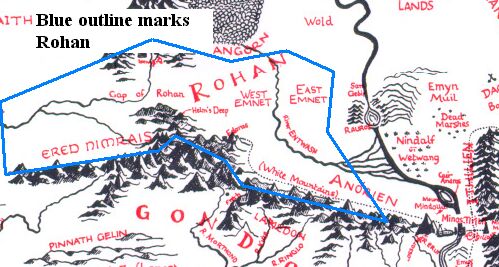
Rohan, or "The Horse Land," is a country of men and was once a province of Gondor. It is also argued to be the smallest region of Middle-earth, but according to most sources, it is not. The Rohirrim, or the people of Rohan, are farmers and are most famous for their wonderful horses, which many have used, including Sauron's Ringwraiths, and Gandalf.
River Isen:
The Isen is a river of Rohan that finds it sources in Nan Curunír and the Ered Nimrais, then flowing south through the Gap of Rohan, it empties eventually into the sea.
Gap of Rohan:
The Gap of Rohan is an area between the White Mountains and the Misty Mountains. The River Isen is in this place.
Helm's Deep:
Helm's Deep is a gorge or canyon that runs deep into the Ered Nimrais Mountains. Helm's Deep was a primary defensive stronghold of Rohan, and the greatest of all of them. It also could serve as a gathering place in a time of great need. Only Dunharrow came close to Helm's Deep in strength. In the years 2758-2759 this place was defended by the warrior Helm, and thus it received its name. It was defended by the King Théoden during the War of the Ring.
The Deeping Stream flowed through Helm's Deep, and the Aglarond was found here. The Aglarond is a great, glittering cave which served as a storage place for the Rohirrim. During the Third Age's Battle of Helm's Deep, Gimli discovered the beauty of these caves when the force he was part of was driven back into them. This is a where a great part of the battle was fought. After the War of the Ring many Ereborian dwarves dwelt in the Glittering Caves. The Deeping Wall was erected as a way to guard the entrance to Helm's Deep.
The name Helm's Deep refers to the canyon in which the fortess of Hornburg sat. Many have confused the name Helm's Deep with the name of Hornburg, and called the fortress itself Helm's Deep, but this is not its true name.
Dunharrow:
The Dunharrow, originally called Dúnharg, was the secondary fortress of Rohan, and like the Hornburg of Helm's Deep, could serve as a gathering place for people during a time of war. It was erected above Harrowdale by the men of the mountains of Gondor, but later, when Rohan became an independent nation, the Gondorians handed over to the Rohirrim.
Only one path wound up through the mountains to Dunharrow, and archers were stationed on levels above the road, so that the fortress was easily defended. It was also on the very brink of a steep cliff.
Nan Curunír:
Nan Curunír is a great valley in the southern region of the Misty Mountains which opens into the gap of Rohan. Nan Curunír is translated as Vally of Saruman, which is rather logical, because Isengard was located in this deep gorge. At one point, Nan Curunír was a wonderfully fertile, fed by the Isen River. However, by the end of the Third Age, Saruman's evil Uruk-Hai had turned most of this land to a bare, near desert-like region. Only a few fertile areas remained, and it was here that Saruman harvested his own form of pipe-weed.
Isengard and Orthanc:
Isengard, or Iron Enclosure, is a fortress built by the Gondorians in early days. It was a stone, circular wall surrounding a great, flat plain. The only gate into Isengard was on the south.
Orthanc stood in the center of Isengard. Orthanc was Saruman's tower. It was originally built by the Dúnadain, and was constructed of black, unbreakable stone, and had four pillars. The top of Orthanc, which towered five-hundred feet above the walls of Isengard, had astronomical symbols carved into the top of it. The Ents attempted to destroy it in the Third Age, unsuccessfully, and it was given to Gondor again, after the demise of Saruman.
